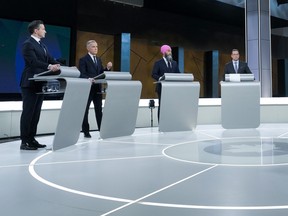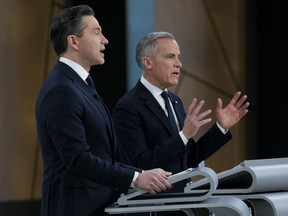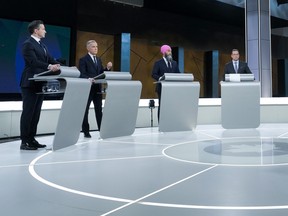Politicians’ penchant for theatre over meaningful talk didn’t start with election debates

Article content
Live TV coverage has hampered modern political discourse.
Advertisement 2
Article content
Article content
Recommended Videos
Article content
Last week’s televised federal leaders’ debates serve as two more pieces of evidence supporting this.
What did anyone genuinely learn? It was more like two free-time political broadcasts — one in English and one in French — with short segments that barely qualified as real, down-to-earth debate.
It’s been like this for many election cycles: The person being questioned by the moderator or their opponent seeks not necessarily to answer the query but rather to regurgitate some tired talking point we’ve all heard before.
Even the moment during last Thursday’s English debate many pundits considered the highlight would be more aptly described as the least-boring part.
Toward the end, Liberal Leader Mark Carney attempted to score a point on Conservative Leader Pierre Poilievre by asking him why he’s refused to obtain his security clearance. Poilievre gave his usual answer and deftly used the occasion to pin Carney on his inaction on interactions between some Toronto Liberal candidates and the Chinese communist party.
Article content
Advertisement 3
Article content
The exchange was entertaining but contained no news.
The only possible net new thing Canadians learned from those 240 minutes of mostly bloviation came during the French debate last Wednesday, when the moderator asked what habit the party leaders had given up in response to the U.S. President Donald Trump’s trade war.
Some of their disdain for tasteless, flavourless U.S. strawberries was the only correct answer. (And I say “possible net new thing” because this strawberry businesses started as a jab at an awkward response Carney gave during an earlier TV interview in French.)
Politicians’ penchant for theatre over meaningful talk didn’t start with election debates, though.

Politicians forever going after the perfect sound bite
I’ve pretty much given up on question period, for example.
What’s meant to be time for federal and provincial parliamentarians to quiz the government has become a vehicle for the creation of a good sound bite or video clip.
Advertisement 4
Article content
Alternatively, the government evades the queries, rendering question period useless.
(And don’t get me started on the heckling. Shame.)
Would the overtly political parts of our assemblies work better without cameras, so our representatives wouldn’t feel the need to show off?
At least question period and leaders’ debates offer a chance at rebuttal, however slim.
The worst type of live coverage would be that of a politician making a speech or an announcement at a news conference.
Whoever’s talking gets free reign to say whatever they want, unchallenged to start.
There’s not necessarily time for a thorough fact check on the spot — and often, when knowledgeable journalists try to question this claim or that, they’re treated as hostile individuals.
By the time the media has had time to go through everything with a fine-tooth comb, it’s very possible the news consumer has already absorbed what they think is fact and turned it all off.
Advertisement 5
Article content
There’s no doubt live pictures, however they’re delivered, are a powerful means of delivering news.
People of a certain age will remember the Sept. 11, 2001, terrorist attacks playing out before their eyes during TV morning shows.
Those who’ve been around even longer will remember fuzzy video of a lone demonstrator facing off against tanks in Beijing’s Tiananmen Square on June 4, 1989.
Late on March 10, 2011, the handful of us working the late-night shift in the newsroom watched slack-jawed as cable news showed the Pacific Ocean swallowing a large swath of coastal Japan near Fukushima after a massive earthquake and tsunami.
Live video can bring a different dimension to journalism when it comes to things like natural disasters, civil unrest, crime and terrorism, allowing everyone to follow evolving information about what is happening at any given moment.
Live coverage of political arguments and government announcements can’t always elevate public knowledge and discourse in the same way — in fact, it may have done us a great disservice by giving the last word to whoever speaks first or flamboyantly, not necessarily whoever speaks earnestly and truthfully.
rleong@postmedia.com
Find Ricky on Bluesky and on X
Recommended from Editorial
-

Mark Carney takes shots from left, right and Bloc during English debate
-

Party leaders didn’t take media questions after the English debate. Here’s why
Article content




